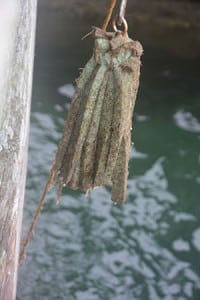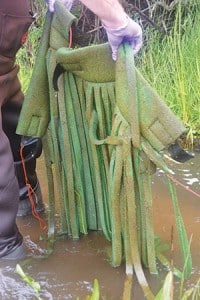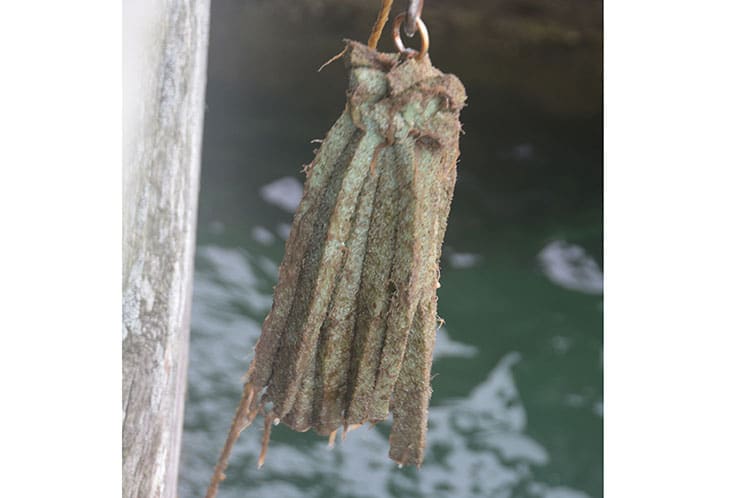• by Dr. Sarah Oktay, Director, University of Massachusetts Nantucket Field Station •

I was pleasantly surprised at how knowledgeable Mr. Ruffalo and the Water Defense team, including Executive Director John Pratt and Chief Scientist Scott Smith, were about water quality issues and source functions, in situ (in place) water testing, and environmental impacts. Their passion and dedication to responding quickly to environmental disasters and their need to get information out to the public quickly impressed me. As a chemical oceanographer with over twenty years of experience (starting at the age of twelve of course) in trace metal, radioisotope, and carbon tracking chemistry in natural systems, I also was naturally curious as to whether their methods were reliable and viable. If CeeLo Green was writing this he’d throw in “undeniable, classifiable, and verifiable” and make this article sound not only cooler but even more scientific. Fortunately, this is a serious group that wants to make a difference by engaging and enabling people to find out what is in their water and helping them remediate or remove these toxins.
Water Defense specifically concentrates on tracking leftover oil and contaminants from oil spills, oil related accidents, and fracking operations around the U.S. Scott Smith started deploying his company’s (http://www.opflex.com/) open cell foam boom material at these sites to see if it could sequester (collect and entrain) oil pollutants. One design uses an artificial eelgrass structure to effectively mimic high surface area materials in nature http://www.opflex.com/index.php/opflex-foam/eelgrass-mops.) This is a type of biomimicry (http://yesterdaysisland.com/biomimicry/). The open cell nature of this foam means that it has tons of sponge-like holes that are formed haphazardly, giving the material a surface area of two square feet for every cubic inch of material. The material is naturally “biophilic” or organic loving and is in effect hydrophobic, which means it attracts organically bound contaminants while releasing or repelling water. It also is relatively inert, and a “green material” with a low carbon footprint and the ability to attract particle reactive materials. Opflex is a petrochemical, like many plastics, so in essence we are fighting fire with fire. OPFLEX materials are much lighter than traditional oil boom material and able to absorb up to 30 times their weight in oil. We are investigating whether they can be used to collect other organic contaminants like pesticides, paints, or construction and cleaning chemicals.
There are two problems that Water Defense and Scott and Mark are trying to address with this new technology. One is that many water sampling groups can only afford to do “snap-shot” type water testing, taking grab samples via trained volunteers at the surface of a pond, lake, bay or river. Often they don’t have the means to do water column testing which requires that special sampling containers called Niskin, Beta, or Van Dorn bottles are used. When researchers want to take a sample of seawater from within the water column they often use a relatively simple device called a Niskin Bottle that can be opened at both ends. The open bottle is lowered into the ocean (or into a pond or bay) on a wire from a boat until it reaches a certain depth and then the bottle is closed by a weighted trigger (called a “messenger”) that is sent down the cable from the surface. My students and I use these in the harbor and in some of our ponds and are able to deploy them from small boats. Although oceanographers and limnologists (those who study freshwater systems) usually take samples from multiple depths and from the sediment too, it is often not possible or affordable for municipalities, civic associations, and citizen science groups who do the lion’s share of water testing in this country to follow suit.

This is where materials like Opflex can be helpful in addition to its use as a media for absorbing oil. The Opflex material can be deployed on moorings, docks, in ponds and along shorelines to passively filter water; individual sections can be removed from the eelgrass mops and sampled over time for gas derivatives, organic pollutants such as pesticides and particle reactive molecules like phosphate who can’t pass by a substrate without wanting to join the party. This material could be placed in filters to extract contaminants from the water column. If you have ever run an aquarium, you will recall that you use a lot of different substances for filtration like charcoal for organic matter, cation exchange columns for metals and biological bacteria present on the surface of bioballs to remove hydrophobic stuff.
The Opflex material is relatively innocuous and inert and easy to deploy by untrained personnel. Here on Nantucket at the UMass Boston Nantucket Field Station, we are evaluating the Opflex material in natural systems by deploying it in different water bodies around the island to see if we can measure specific contaminates of concern (CECs). We want to understand what it records in pure water (intrinsic background levels), what its detection limits are and how it holds up in real world environments. We will also be retrieving and testing it throughout the season to evaluate its effectiveness as a time capsule for long term sampling. Evaluating long term chemical burdens can help us understand what scallops or fish or osprey may be dealing with as well as what types of issues (or non issues) humans may encounter. Toxic chemicals can have sudden or acute effects or long term chronic effects. Starting in a controlled environment such as Nantucket with no industry and identifiable sources of contaminants makes it much easier to apply these tools worldwide.
Come see for yourself this Saturday June 28th at 10:00 am at the Nantucket Field Station at 180 Polpis Road. You can meet Mark Ruffalo and the rest of his team, hear about recent Cape and Island testing results, and see a demonstration of how Opflex’s material can be used as a long term water sampler. We will have a short press conference from 10-11 am; feel free to email me at sarah.oktay@umb.edu for more information. I hope you can also catch the Nantucket Film Festival’s Spotlight Film, Begin Again, starring Keira Knightley, Adam Levine and Mark Ruffalo and written and directed by John Carney at the Dreamland’s Main Theatre at 12:45 pm. Come early to hear Mark Ruffalo introduce the film. Go to https://www.youtube.com/watch?v=CwLuDO_Cxfc to see the trailer. Last but not least, please do your part to keep our water clean and our environment healthy.



